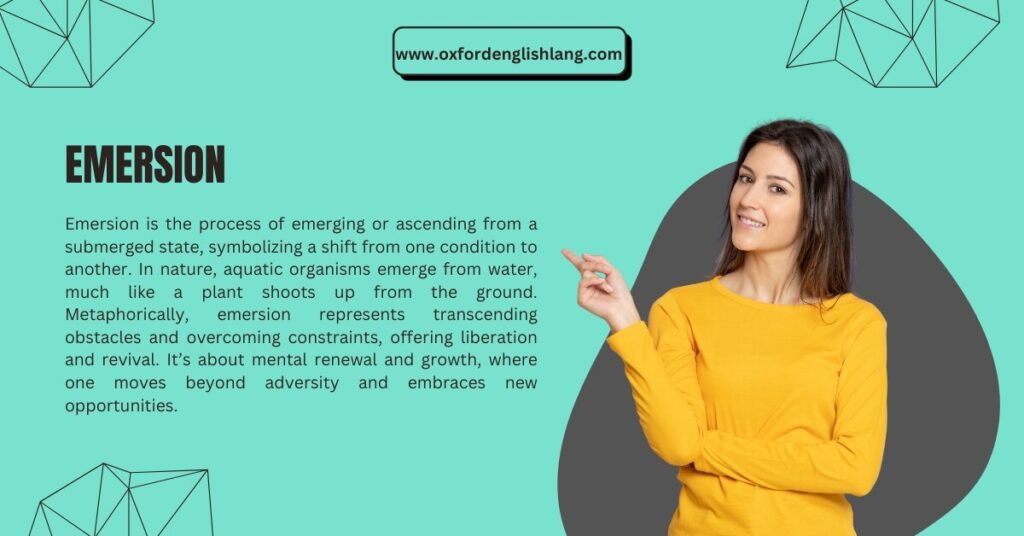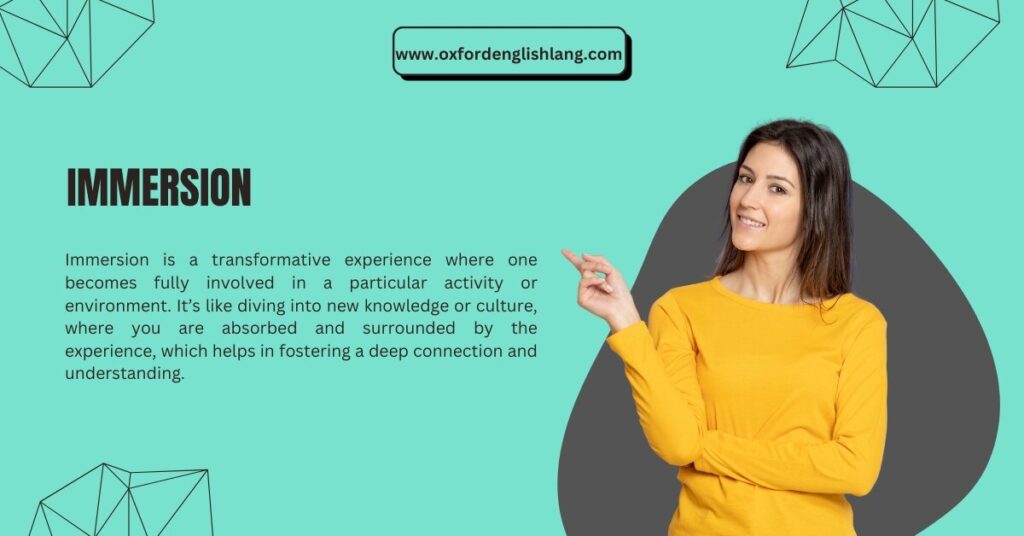When discussing emersion and immersion, we delve into two concepts that shape how we interact with our surroundings and experiences. Rooted in Latin, these terms may seem similar but hold distinct meanings. Immersion refers to being deeply engaged or submerged in an activity or environment, while emersion is about rising from such states, gaining a fresh perspective.
Imagine a diver taking a deep dive into the ocean, fully engrossed in the beauty beneath the surface—that’s immersion. When the diver resurfaces, experiencing the vast horizon above, that’s emersion.
These terms extend beyond the physical, influencing abstract and metaphorical realms. For instance, in educational settings, students in a language program may experience immersion by practicing with native speakers and engaging in hands-on learning. This demands dedication, fluency, and active participation in real-world contexts. Emersion happens when they step out of this environment, ready to apply their skills in everyday life. Such transitions between states are crucial for personal growth and development.
In the world of technology, virtual and augmented reality provide immersive simulations that allow users to explore new realms. For example, a simulation might recreate the experience of walking on a distant planet, offering a captivating glimpse into the unknown. When the headset is removed, users undergo emersion, returning to their physical surroundings with enhanced awareness. This interplay between immersion and emersion highlights the applications of these states in fields like education, entertainment, and personal development.
The difference between immersion and emersion can also be seen in nature. Consider the organisms in coastal areas during high and low tide. During high tide, many are submerged, hidden from view, representing immersion. As the tide recedes, these same organisms become visible, showcasing the process of emersion. Similarly, in astronomy, the reappearance of a celestial body after an eclipse is an example of emersion, while its disappearance represents immersion.
On a personal level, we often experience these states in our hobbies and passions. Whether it’s practicing an instrument, painting, or engaging in other creative pursuits, immersion allows us to become fully engrossed in our work. The process requires refinement, skills, and a commitment to explore the intricacies of our craft. Emersion comes when we step back, assess our progress, and incorporate these efforts into our broader life journey.
Both states involve distinct phases that enhance our understanding of contexts and improve our ability to navigate complex scenarios. For example, the submersion of a seal during a dive and its eventual surfacing in a harbor reflect this duality. These transitions, whether in natural or metaphorical settings, underscore the importance of balancing focused engagement with moments of reflection.
By embracing the meanings of immersion and emersion, we gain clarity and understanding about how to effectively engage with our surroundings. From students in immersive language programs to organisms adapting to tidal shifts, these concepts are deeply embedded in our daily lives. The metaphors of shadow and light, submersion and surfacing, illustrate how these states align with personal growth and broader life transitions.
Emersion Vs Immersion
Immersion is about being deeply engaged and absorbed in something, fully surrounded by it. Emersion, on the other hand, refers to the process of emerging or rising from a submerged state. While immersion focuses on total involvement, emersion emphasizes transition and exposure.
Emersion

Emersion is the process of emerging or ascending from a submerged state, symbolizing a shift from one condition to another. In nature, aquatic organisms emerge from water, much like a plant shoots up from the ground. Metaphorically, emersion represents transcending obstacles and overcoming constraints, offering liberation and revival. It’s about mental renewal and growth, where one moves beyond adversity and embraces new opportunities.
In contexts like therapy, emersion can mean stepping out of a challenging phase, much like immersing oneself in nature for relaxation. It also applies to cultural transitions, such as adapting to a foreign culture, where individuals grow by immersing themselves in new experiences. Ultimately, emersion is a journey of metamorphosis, where one ascends from difficulties, evolving into a stronger, more capable version of themselves.
20 examples for Emersion
- After years of struggle, he experienced emersion from his mental challenges, feeling a renewed sense of liberation.
- The aquatic organisms began their emersion as the tide receded, revealing them from beneath the water.
- After the adversity she faced, her emersion from the difficult phase marked the beginning of a new chapter in her life.
- The plant shoots pushed through the ground, symbolizing emersion and new growth.
- His emersion from the deep contemplations allowed him to embrace new opportunities and development.
- The cultural emersion program helped students fully integrate into a foreign environment and learn the language.
- As the eclipse ended, the celestial body began its emersion, reappearing in the sky.
- The emersion of the sun after the storm brought a sense of renewal and hope.
- The therapist encouraged emersion from the stress of daily life through relaxation in nature.
- After months of immersion in a new hobby, he found his emersion into the world of painting to be incredibly fulfilling.
- The emersion of new technologies has revolutionized the way we interact with the world.
- Emersion from the shadows of doubt allowed her to step confidently into her new role.
- As the organisms began to surface during low tide, their emersion from the water was a beautiful sight.
- After years of hard work, his emersion as a skilled musician was celebrated by his peers.
- The emersion of the seal from the water marked the end of its dive.
- The mental emersion from a period of depression gave her a fresh outlook on life.
- His emersion from a tough situation was like a metamorphosis, where he emerged stronger than before.
- Emersion from constraints and obstacles allowed the company to innovate and thrive.
- The emersion of new ideas and concepts in the field of technology continues to change the world.
- Emersion from the deep immersion in studies gave the students the clarity to apply their knowledge in real-world situations.
Immersion

Immersion is a transformative experience where one becomes fully involved in a particular activity or environment. It’s like diving into new knowledge or culture, where you are absorbed and surrounded by the experience, which helps in fostering a deep connection and understanding.
The importance of engagement in this process is clear—it allows you to embrace the subject and truly appreciate it. Whether in classes or real-world settings, being immersed in something allows you to gain a heightened sense of connection and really understand the subject on a deeper level. Engagement in such experiences is key to personal growth and learning.
20 examples for Immersion
- Immersion in a new culture helps you understand different perspectives.
- The immersive experience in virtual reality is truly transformative.
- Immersion in knowledge allows you to become an expert in a subject.
- A deep immersion in environmental studies can change your view of nature.
- Immersion in a foreign language helps you learn it faster.
- Immersion in art can help you appreciate its true beauty.
- A classroom setting that encourages immersion in the subject increases engagement.
- Immersion in a new activity can be a transformative learning experience.
- Immersion in hands-on projects helps you understand concepts better.
- Immersion in history through reading primary sources can give you a deeper understanding.
- Immersion in a subject for hours at a time can lead to mastery.
- Immersion in nature has a calming effect on the mind and promotes relaxation.
- The immersion of students in real-world scenarios prepares them for the workforce.
- Immersion in technology changes how we interact with the world around us.
- Immersion in different cultures can transform your worldview.
- A deep immersion in music can help you understand its emotional impact.
- Immersion in physical activities helps improve both mental and physical health.
- The immersion of an actor in their role makes their performance more authentic.
- Immersion in scientific research is crucial for developing new theories.
- Immersion in educational games can make learning more engaging and fun.
You Might Also Like: Which of the Following: Definition + Grammar + Complete Usage
What is main differences of Emersion and Immersion
- Emersion refers to the emergence or transition from being submerged in a substance or environment to being exposed or above the surface.
- Immersion, on the other hand, is the state of being fully submerged or deeply involved in an activity, environment, or substance.
- Emersion suggests a change in visibility, as something or someone comes out of a liquid or substance.
- Immersion is more about the act of being completely absorbed or surrounded by something, often leading to a deeper understanding or engagement.
- While emersion often symbolizes relief or liberation, immersion focuses on engagement and internal motivation.
- Immersion tends to be a prolonged experience, whereas emersion is typically temporary and marks a transition.
- The process of immersion often involves complete involvement, while emersion represents a gradual disconnection or escape.
- Immersion is symbolic of deep focus and attachment, while emersion reflects the act of coming out of something.
- In educational contexts, both concepts are valuable: immersion helps with learning and understanding, while emersion encourages reflection.
- Immersion emphasizes total engagement, while emersion focuses on the transition and exposure that follows.
When to use Immersion and Emersion
Immersion is used when describing the act of being deeply involved or absorbed in something, like being completely submerged in water or diving into a new culture. For example, when you are immersed in a book, you are so absorbed that you lose track of time. Similarly, virtual reality creates an immersive experience, where you feel completely surrounded by the environment. The key idea behind immersion is being fully engaged, whether it’s in an activity or an experience.
On the other hand, emersion refers to the process of coming out or rising from something, like a butterfly emerging from its chrysalis or a plant pushing through the soil. It symbolizes a transition from being hidden or submerged to becoming visible. You would use emersion when talking about something or someone coming out of a deep or hidden state, such as the moon becoming visible after being obscured by the Earth’s shadow.
Immersive Learning: Dive Deep into the World of Knowledge
Immersive learning is like diving into a sea of knowledge where you are fully engaged and absorbed in the subject. Just like immersion in water, this type of learning involves being completely surrounded by the material, whether through interactive activities, real-world experiences, or virtual reality technology.
By being deeply involved, students can gain a heightened sense of understanding and connection to what they are learning. This approach helps students retain information better and encourages a more engaging and transformative experience, making the learning process feel like a journey rather than just an academic task.
Embracing Novelty and Curiosity: the Power of Immersive Learning
Immersive learning encourages students to embrace novelty and curiosity by fully diving into new subjects or environments. This method allows learners to be completely absorbed in their experience, whether it’s through exploring a new culture, solving real-world problems, or interacting with virtual reality. Just like immersion in water, learners are surrounded by the material, which fosters a deeper understanding and connection.
The process of being deeply engaged helps them stay focused, making the learning journey more exciting and impactful. In this way, immersive learning taps into the power of curiosity, allowing learners to transition from simply gaining knowledge to actively experiencing and exploring it.
You Might Also Like: How Are You Fairing or Faring? Discover the Powerful Difference!
Language Immersion: Unlocking New Worlds and Cultural Connections
Language immersion is a powerful way to learn a new language by being completely absorbed in the environment where the language is spoken. When you are immersed in a language, you are surrounded by it in everyday situations, which helps you understand and connect with the culture in a deeper way. This type of immersion allows you to experience the language in its natural setting, making it easier to focus on learning and appreciating the nuances of communication.
Frequently Asked Questions
Q. What is the meaning of emersion and immersion?
Emersion refers to the act of emerging or coming out of a submerged or hidden state, while immersion means being deeply involved or absorbed in something, like a task or environment.
Q. What are the key differences between emersion and immersion?
The key difference is that emersion focuses on emerging or transitioning out of something, while immersion emphasizes being completely absorbed or engaged in an activity or environment.
Q. Can you provide examples of emersion in everyday life?
Examples of emersion include a butterfly emerging from its chrysalis or a plant pushing through the soil to the surface.
Q. How about examples of immersion in daily experiences?
Immersion examples include diving into a new culture, using virtual reality to experience new worlds, or being fully absorbed in a book or study.
Q. In terms of personal development, how can emersion and immersion be applied differently?
In personal development, emersion can help with self-reflection and growth, while immersion can accelerate learning and mastery by fostering complete engagement in a subject.
Q. How do emersion and immersion relate to the concept of mindfulness?
Emersion and immersion both relate to mindfulness, with immersion helping to stay present in the moment, while emersion encourages reflection and transitioning to new levels of awareness.
Q. How do emersion and immersion differ in their psychological implications?
Emersion in psychology involves detachment or transitioning out of a situation, while immersion is linked to deep involvement, which can lead to heightened focus and understanding.
Conclusion
In conclusion, emersion and immersion are two distinct but complementary concepts that play significant roles in personal growth, learning, and experiences. While immersion focuses on being deeply absorbed or engaged in a task or environment, allowing for complete involvement and heightened understanding, emersion involves the process of emerging or transitioning out of a situation, often leading to reflection and growth. Both have their unique psychological and developmental implications, with immersion fostering focus and intense involvement, and emersion offering opportunities for detachment, liberation, and self-reflection. By understanding the differences and applications of these concepts, we can harness their power to enhance learning, mindfulness, and personal development in various aspects of life.

david Miller is an experienced English language expert with a deep passion for helping others communicate effectively and confidently. With a background in linguistics and literature, He provides clear, accessible insights on grammar, writing, and communication strategies. Through well-researched articles and practical advice, David Miller aims to make language learning both inspiring and achievable for readers of all levels.


